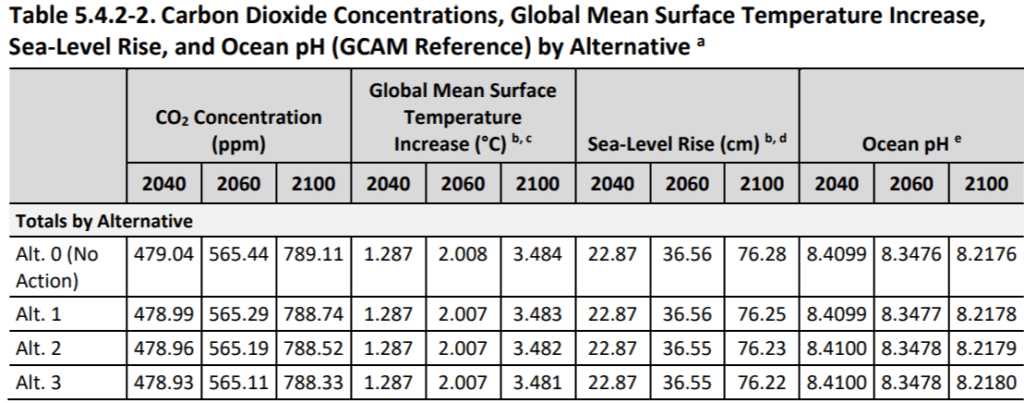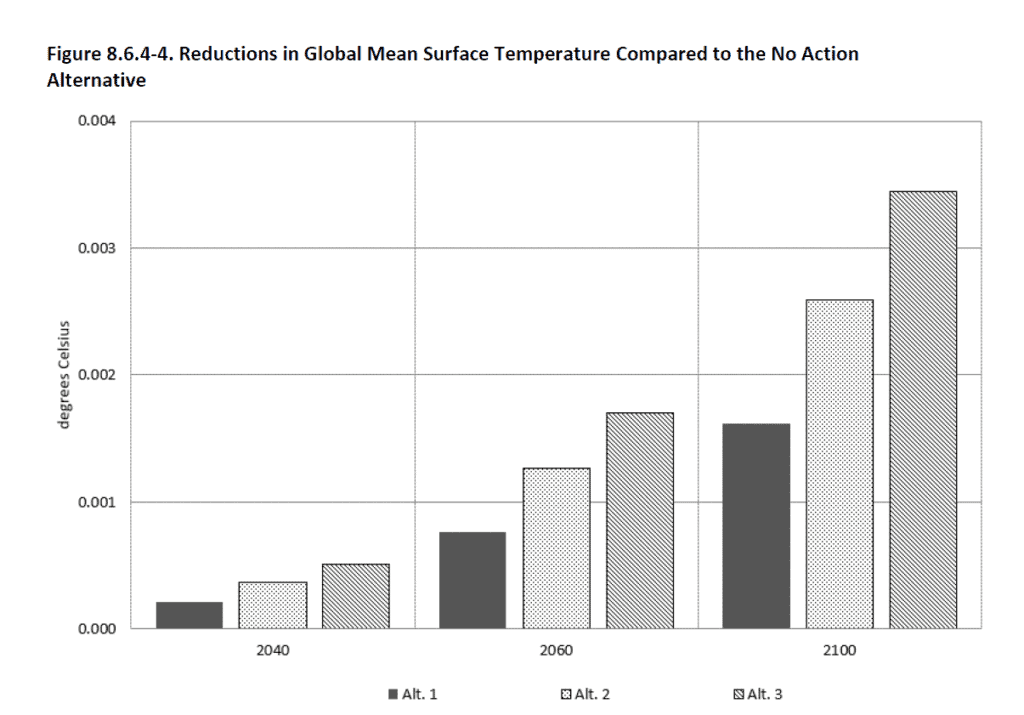CEI Comments on the National Highway Traffic Safety Administration’s Proposed Fuel Economy Standards for Model Year 2024-2026 Passenger Cars and Light Trucks
Comments submitted by Patrick J. Michaels, Kevin Dayaratna, and Marlo Lewis.[1]
Thank you for the opportunity to comment on the National Highway Traffic Safety Administration’s (NHTSA) proposed corporate average fuel economy (CAFE) standards for model years (MYs) 2024-2026 light duty vehicles.[2]
NHTSA invites comment on three alternatives to the Trump administration’s Safer Affordable Fuel-Efficient (SAFE) Vehicles Rule. Under the SAFE Rule, CAFE standards increase in stringency beyond MY 2020 levels by 1.5 percent annually during MYs 2021-2026.[3] Table IV-1 compares NHTSA’s three proposed alternatives to the SAFE Rule. Alternative 2—an 8 percent annual increase in regulatory stringency during MYs 2024-2026—is NHTSA’s “preferred” alternative.[4]

We oppose replacing the SAFE Rule with more stringent regulatory requirements. Fuel economy standards have three unavoidable downsides. Such policies (1) increase vehicle ownership costs,[1] (2) restrict consumer choice,[2] and (3) make the average vehicle less crashworthy than it otherwise could be.[3] The more stringent the standards, the more severe those adverse effects are likely to be.
We expect other commenters to discuss CAFE’s inherent drawbacks in greater detail, and so will not say more about that here. Our focus is on the proposed rule’s putative climate benefits and the social cost of carbon (SCC) methodology on which NHTSA relies. We show that the rulemaking’s projected climate benefit estimates are artifacts of bias and speculation. By necessary implication, our critique calls in question the proposal’s total benefit and net-benefit estimates.
Section 1: Total Benefits, Climate Benefits
NHTSA calculates the proposed CAFE standards’ costs and benefits under two “perspectives”—model year (MY) and calendar year (CY). The MY perspective “considers the lifetime impacts attributable to all vehicles produced prior to model year 2030, accounting for the operation of these vehicles over their entire useful lives (with some model year 2029 vehicles estimated to be in service as late as 2068).” The CY perspective “includes the annual impacts attributable to all vehicles estimated to be in service in each calendar year” during 2021-2050.[4] The costs and benefits are larger in the CY perspective because it “emphasizes longer-term impacts that could accrue if standards were to continue without change.”[5] For example, assuming a 3 percent discount rate, the costs, benefits, and net benefits of NHTSA’s preferred alternative are $121.1 billion, $121.4 billion, and $0.3 billion, respectively, in the MY perspective, but $333.6 billion, $433.6 billion, and $100 billion, respectively, in the CY perspective. See Tables I-5 and I-8 below:


Using a 3 percent discount rate, NHTSA estimates alternatives 1, 2, and 3 will reduce climate damages by $20.3 billion, $32 billion, and $45.6 billion, respectively, in the MY perspective,[1] and $71.6 billion, $118.2 billion, and $161.4 billion, respectively, in the CY perspective.[2]
One implication of the numbers and tables above is that the proposal’s climate benefits are critical to achieving positive net benefits—a rule in which total benefits exceed costs. For example, assuming a 3 percent discount rate, if climate benefits are $0.00, Alternative 2 produces net benefits of -$31.7 billion in the MY perspective and -$18.2 billion in the CY perspective.
Section 2: Summary of Argument The proposal’s projected climate benefits are phantasms. Those benefits derive from the Biden administration Interagency Working Group’s (IWG) social cost of carbon (SCC) estimates.[3]
Whatever its value as an academic research tool, SCC estimation is too speculative and assumption-driven to inform policy decisions. The seeming objectivity and precision of official SCC estimates are illusory.
Unsurprisingly, SCC estimates are easily manipulated for political purposes. The IWG process is a prime case in point. All of the IWG’s methodological decisions err on the side of alarm and regulatory ambition.
Those dubious decisions include the use of below-market discount rates, an analysis period extending far beyond the limits of informed speculation, outdated climate sensitivity assumptions, unscientific depreciation of carbon dioxide fertilization benefits, unjustified pessimism regarding human adaptive capabilities, implausible “return to coal” baseline emission scenarios, and net-benefit calculations that misleadingly compare domestic costs to global benefits. Absent those biases, the IWG’s SCC estimates could fall to zero dollars or below during 2021-2050 and beyond.
Even if the IWG’s methodology were not biased in multiple ways, NHTSA’s claim that its preferred alternative would deliver $118.2 billion in climate benefits in 2050 would still defy common sense. In the agency’s own analysis, the preferred alternative reduces global average temperature by less than 0.0013°C in 2050.[1] That hypothetical change would be far too small for scientists to detect. It would make no discernible difference to weather patterns, crop yields, polar bear populations, or any other environmental condition people care about. Benefits no one can experience are “benefits” in name only.
Section 3: Social Cost of Carbon Basics
The SCC is an estimate in dollars of the cumulative long-term damage caused by one ton of carbon dioxide (CO2) emitted in a specific year. That number also represents an estimate of the benefit of avoiding or reducing one ton of CO2 emissions.
The computer models used to project SCC values are called integrated assessment models (IAMs) because they combine aspects of a climate model, which estimates the physical impacts of CO2 emissions, with an economic model, which estimates the dollar value of climate change effects on agricultural productivity, property values, and other economic variables. The IWG uses three IAMs—abbreviated DICE, FUND, and PAGE—to estimate SCC values.[2]
SCC estimates are highly sensitive to:
- The discount rates chosen to calculate the present value of future emissions and reductions.
- The climate sensitivity assumptions chosen to estimate the warming impact of projected increases in atmospheric GHG concentration.
- The timespan chosen to estimate cumulative damages from rising GHG concentration.
- The choice of socioeconomic pathways used to project future GHG emissions and concentrations.
- The extent to which the SCC reflects empirical information about the agricultural and ecological benefits of carbon dioxide fertilization.
- The assumptions chosen regarding the potential for adaptation to decrease the cost of future climate change impacts.
In addition, from a political perspective, it matters a great deal whether the net benefits of climate policy proposals are calculated by comparing the domestic costs of GHG-reduction policies to the IAM-estimated global climate benefits or to the much smaller domestic benefits.
What this all means is that, if a modeler intends to make climate change look economically catastrophic and build a case for aggressive regulation, the modeler:
- Runs the IAMs with below-market discount rates.
- Uses IAMs that assume high climate sensitivity.
- Calculates cumulative damages over a 300-year period—i.e., well beyond the limits of informed speculation about future economic vulnerabilities and adaptive technologies.
- Runs the models with implausible emission scenarios that assume the world repeatedly burns through all economically-recoverable fossil fuel reserves.
- Minimizes the immense agricultural benefits of atmospheric CO2 fertilization by, for example, averaging the results of three IAMs, two of which effectively assign a dollar value of zero to carbon dioxide’s positive externalities.
- Includes at least one IAM that assumes adaptation cannot mitigate the cost of climate change impacts once relatively modest levels of global warming and sea-level rise are exceeded.
- Calculates climate policy net benefits by comparing apples (domestic costs) to oranges (global benefits).
In other words, the modeler does exactly what the Obama IWG did in its 2010, 2013, and 2016 technical support documents (TSDs), and what the Biden IWG proposes to do in its 2021 interim TSD.[3]
Section 4: Artifactual Benefits No One Will Ever Experience
What will be the proposed CAFE standards’ measurable effects on global average surface temperature, compared to the existing SAFE Rule standards, and what benefits can be expected to accrue from the proposed changes?
In a word, the answer to both is simple: None.
NHTSA uses the Model for the Assessment of Greenhouse Gas-Induced Climate Change (MAGICC),[4] developed by the National Center for Atmospheric Research, to estimate the proposed CAFE standards’ greenhouse gas emission reductions and associated climate effects. Table 5.4.2-2 of NHTSA’s Draft Supplemental Environmental Impact Statement presents the overall results.

As can be seen above, in 2060, NHTSA’s preferred alternative reduces CO2 concentrations in 2060 by 0.25 parts per million, avoids 0.001°C of global warming, and averts 0.01cm of sea-level rise.[1] More precisely, NHTSA projects a 0.0013°C reduction in global mean surface temperature from Alt. 2 in 2060 (see Figure 8.6.6-4, below).[2]
So, we may reasonably infer Alt. 2 produces about 0.001°C of warming mitigation by 2050. For perspective, that is about one-third the average temperature difference between the air surrounding your knees and the air surrounding your midsection.
More importantly, according to the National Oceanic and Atmospheric Administration, the inherent error in current calculations of annual global average surface air temperature is 0.08°C, which is roughly 80 times the calculated effect of the new standards in 2050.[3] Yet when NHTSA multiplies the projected emission reductions by the IWG’s SCC estimates, it comes up with $118.2 billion in climate benefits by 2050.

It simply defies logic to calculate the benefits of a regulation that will have impossible-to-detect effects on surface temperature, because it is those same temperature changes that drive cost estimates.
In short, the proposed vehicle standards will have an undetectable effect on surface temperature, which means the standards will produce undetectable climate “benefits.” Benefits no one can experience exist only in the virtual world SCC modeling. The proposal’s climate benefits are not real enough to be netted against the hundreds of billions of dollars in costs the proposal will impose on automakers and consumers.
Read the full comments as a PDF.
